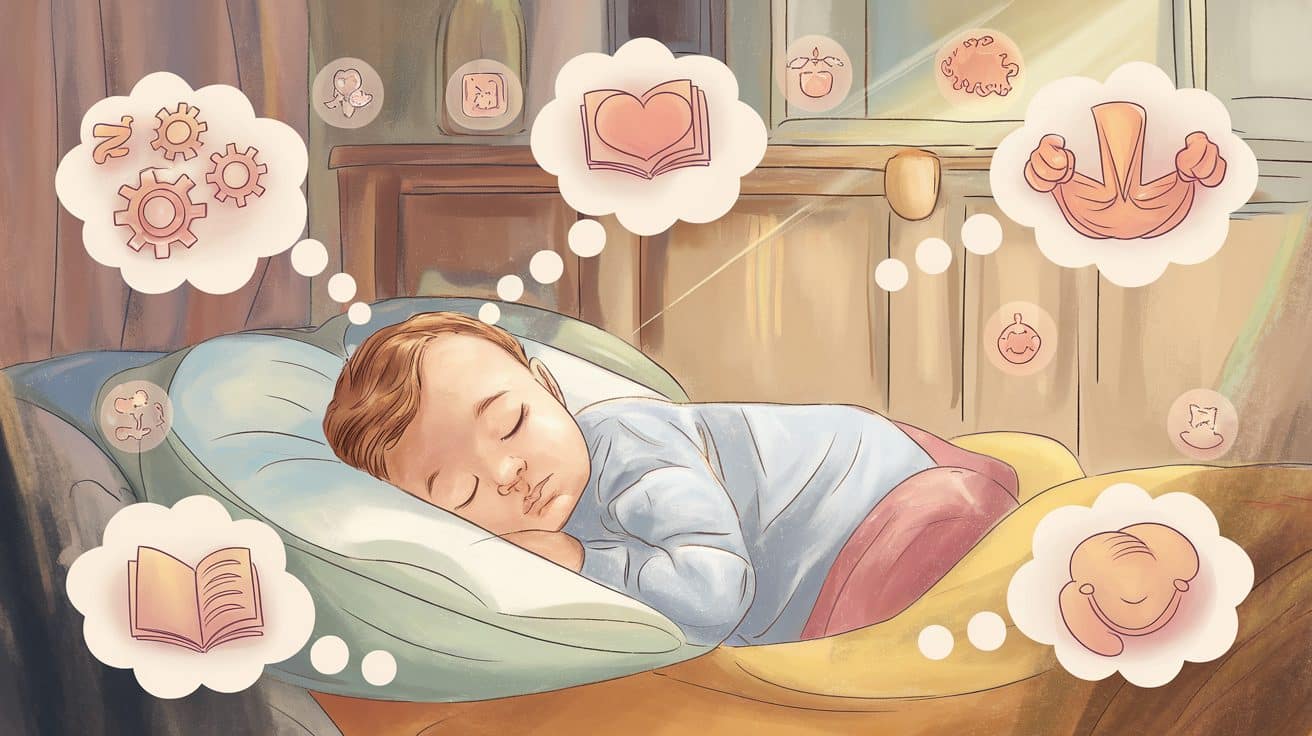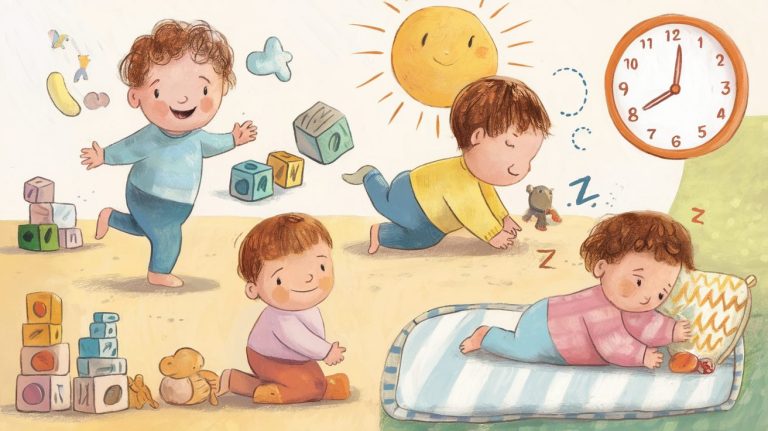Let’s be real: getting a toddler to nap can feel like a mission impossible. One minute, they’re full of energy; the next, they’re cranky and tired but fighting sleep with everything they’ve got.
Trust me, I’ve been there.
As a parent, I know how critical naps are. They’re not just a break for you – they’re essential for your child’s growth and happiness.
If you’re dealing with a 2-year-old not napping, you’re not alone. It’s a common challenge, but there are solutions.
Imagine a day without a meltdown. Sounds like a dream, right?
This guide will walk you through 10 effective techniques to make your toddler nap, helping both you and your little one get the rest you need.
How Many Naps Does a Toddler Need?

Toddlers are like tiny energy machines. Most children need 1-2 naps daily, but every child is different.
Some kids might need more rest, while others seem to run on pure excitement.
Their nap needs change as they grow, depending on how active they are and how quickly they’re developing.
Sleep isn’t just downtime – it’s brain-building time! Naps help toddlers grow stronger, think clearer, and manage emotions better.
Think of naps as secret recharge sessions that keep your little one happy and healthy.
Top 10 Effective Techniques for Better Toddler Naps
1. Create a Consistent Nap Schedule
Creating a consistent nap schedule can be a game-changer for your little one.
If your baby fights naps, try setting a regular nap time that fits your daily routine. You can choose a time based on when your baby wakes up in the morning or pick a specific time each day.
Sticking to a schedule helps regulate your baby’s body clock and makes napping easier. Look for signs that your baby is tired, and be consistent with nap time while allowing for some flexibility.
Establishing a calm, soothing pre-nap routine can also make nap time more pleasant for both you and your baby.
2. Keep a Pre-Nap Routine
Before naptime, it’s important to have a special routine that helps your toddler calm down and get ready for sleep.
This pre-nap routine is like a secret message to your child’s brain, telling it that it’s time to relax and rest.
Simple activities like reading a short book, singing a gentle song, rocking slowly, cuddling quietly, or listening to soft music can all be part of this routine.
By doing the same things each time before a nap, you’ll help your toddler understand that it’s time to wind down and prepare for a peaceful sleep.
3. Set a Calm Environment
Setting up a calm environment is crucial for helping your baby sleep peacefully. Transform their room into a soothing and peaceful space that promotes relaxation.
Ensure the room is very dark by closing the curtains tightly and removing any bright toys or electronics that might distract your little one. Keep the room quiet, and use soft, dark blankets to create a cosy atmosphere.
Maintain a cool temperature in the room and consider playing gentle, soothing sounds to help your baby drift off to dreamland.
Remember to remove anything that might potentially wake them up, creating the perfect sleep-friendly environment.
4. Avoid Overstimulation Before Nap Time
Before nap time, it’s important to avoid activities that are too exciting for your child. Imagine your child’s energy as a spinning top.
Games that are very active can make that top spin out of control. Instead, you want to help your child slow down and relax.
Calm activities like listening to soft music, reading quietly, doing simple puzzles, colouring gently, or having quiet cuddles can work wonders.
About an hour before nap time, switch to a peaceful mode. Avoid jumping, loud games, and screens.
5. Watch for Nap Time Cues
When it’s close to nap time, your toddler’s body will give you hints that they need to rest.
They might rub their eyes, yawn a lot, or become cranky. Some kids might want to be held or suddenly lose interest in playing. Others may get quiet all of a sudden.
If you see these signs, it’s time to get your toddler ready for a nap.
6. Use a Comfortable Sleep Space
My son used to fall asleep everywhere in his bed. Car rides? Instant snooze. Swings? Knockout city. But those weren’t real sleep spots.
To help your toddler develop good sleep habits, it’s important to provide a comfortable and consistent sleep space.
While car rides and swings may seem like easy ways to get your little one to doze off, they’re not ideal for quality rest. Instead, create a safe, cosy, and quiet environment in your child’s bed or crib.
7. Encourage Self-Soothing
When it comes to helping your little one sleep, self-soothing can be a game-changer. Many children find comfort in a special object, like a soft blanket or a cuddly stuffed animal.
Others may prefer gentle background noise or soothing music. To encourage self-soothing, start small and give your child some space to figure it out on their own.
Don’t rush in at every little sound they make. Instead, create a calm bedtime routine and stay nearby but not too close. With patience and kindness, your child will learn to self-soothe and drift off to dreamland.
8. Avoid Napping Too Close to Bedtime
Try to avoid letting your toddler nap too close to their bedtime. When they take a nap late in the afternoon, it can make it harder for them to feel sleepy when it’s time to go to bed for the night.
It’s best to have a gap of at least 3 hours between the end of their nap and the start of their bedtime routine.
This way, your child will have enough time to get tired again before it’s time to sleep.
Keep an eye on the time, schedule naps earlier in the day, and watch for signs that your toddler is getting sleepy. Remember to keep the evening calm and peaceful to help them wind down for bed.
9. Keep a Regular Wake Time
Waking up at the same time every day might seem challenging, but it works wonders for toddlers!
Their bodies are like little clocks that thrive on routine. By waking your child at the same time each day, even on weekends, you help maintain a consistent sleep pattern.
This may be met with some resistance initially, but it ultimately leads to a more seamless routine.
A regular wake time helps set your toddler’s internal sleep schedule, makes nap times more predictable, keeps energy levels balanced throughout the day, and reduces fussiness.
10. Stay Calm and Consistent
Take a deep breath.
Consistency is your secret weapon. It might not work perfectly every time, but keep trying. Your calm approach matters more than you think.
Kids pick up on our energy. When you stay cool and steady, they feel safe. Your patience will win – maybe not today, but soon.
Conclusion
Helping your 2-year-old not napping can feel challenging, but with the right techniques, you can establish a calm naptime routine.
Every child is different, so what works for one may not work for another. Patience, consistency, and love are essential.
Naptime is a process, not a quick fix—some days will go smoothly, while others may feel tougher.
By trying these strategies, you’re taking steps to support your toddler’s rest. Stay positive and trust your efforts, even on the harder days.
You’re doing a great job, and with time, naptime will become easier. You’ve got this, parents!
Frequently Asked Questions
Is It Ok for A 2-Year-Old Not to Nap?
While some 2-year-olds can skip naps, most still need them. If your child isn’t tired without a nap, try quiet time instead. Ask your doctor for specific advice.
How Long Does a 2-Year-Old’s Nap Regression Last?
Nap changes can last from a few days to several weeks. Keep a steady schedule and stay patient – each child is different.
How Do I Get My Stubborn 2-Year-Old to Nap?
Set a regular nap time in a dark, quiet room. Try calm activities if they won’t sleep. Stay consistent with the routine, and use gentle praise.
Can You Give a 2-Year-Old Melatonin?
Talk to your child’s doctor first. While melatonin is natural, it’s not right for every child. Better sleep habits often work better than supplements.










